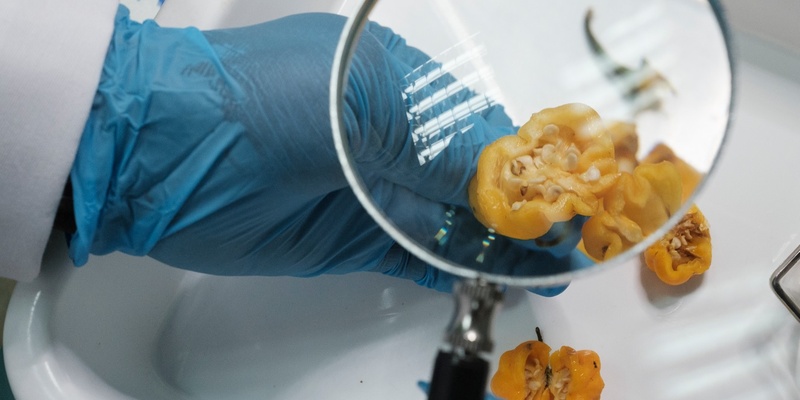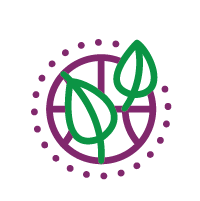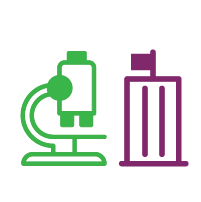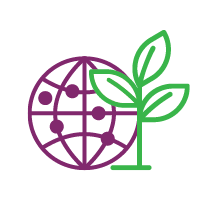¿Qué es una Evaluación de la Capacidad Fitosanitaria (ECF)?
The PCE is a collaborative process that helps countries evaluate their phytosanitary capabilities. National stakeholders, including the national plant protection organization (NPPO) staff, reach a consensus on the main phytosanitary gaps at the system, organizational, and technical levels. Under a structured framework, the PCE process helps identify how to address these critical gaps based on strategic planning and logical framework methodologies.
The PCE:
- Is a self-evaluation process driven by the NPPOs, giving them flexibility and control. Usually, it involves internationally trained facilitators who serve as navigators and guide the NPPOs in conducting a thorough assessment. However, the country may decide to conduct the assessment independently;
- Is supported by an online system comprising 13 modules designed in a questionnaire-style format to document the evaluation process systematically. NPPOs can select modules based on their current priorities and needs;
- Once the gaps are identified, the NPPO can create a sovereign plan to address and rectify these issues by applying strategic planning tools such as cause and effects analysis, SWOT analysis, logical framework, and the final output, a phytosanitary capacity development strategy which is validated by stakeholders.
To find out more about the PCE process and how to start one in your country, read the next steps below or contact Sarah Brunel, IPPC Implementation Facilitation Lead, at
[email protected]
PCEs in practice: examples and case studies
 ¿Cuáles son los beneficios de una ECF?
¿Cuáles son los beneficios de una ECF?
 ¿Quién dirige el proceso de la ECF?
¿Quién dirige el proceso de la ECF?
The process is driven by staff of the NPPO but should involve non-NPPO representatives from appropriate government agencies, research institutes, universities, agro-industries or import/export associations, etc.
The presence of an IPPC-certified PCE Facilitator streamlines the process while ensuring coordination and neutrality. Furthermore, the Facilitator's participation in the workshops enables participants to get a clearer understanding of the questions, Result-Based Management tools and suggestions on the next steps to take. Finally, the Facilitator supports the NPPO staff and private stakeholders in navigating through the PCE platform and briefs the participants in a teaching/training methodology prior to starting the process.
"PCE Facilitators guide discussions towards productive conclusions while refraining from expressing personal opinions, ensuring NPPOs and stakeholders take full ownership of the process. Facilitators also contribute to preserving the quality and integrity of the evaluation methodology by explaining and teaching the methodology and overseeing procedural aspects of workshops. It's important to note that facilitators enhance the objectivity of the evaluation practice".
 What does the PCE consist of?
What does the PCE consist of?
The goal of the process is to reach a consensus and develop a structured plan involving the country's stakeholders that addresses weaknesses and enhances the country's capacity in plant health. The PCE process will end in a National Phytosanitary Capacity Development Strategy and new or revised legislation/regulation.
To develop a National Phytosanitary Capacity Development Strategy, the process involves three PCE missions and various stakeholders who work together to identify gaps using a structured questionnaire format during the first mission. During the second PCE mission, strategic planning tools are used to develop a tailored plan for each module. The third mission involves validating the PCE findings, including activities and estimated costs, and following up on the implementation of the strategy and resource mobilization.
When the country selects to work on a new or revised legislation/regulation (Module 2), the process begins with a thorough Situation Analysis to assess the current legal framework's strengths and weaknesses during a first legal mission. As decided by the NPPO, drafting and consultation follow, involving stakeholders' input and the creation of a draft of new or revised legislation/regulation that addresses identified gaps. This draft is then reviewed and validated, ensuring legal soundness and international alignment. Finally, the Follow-up phase focuses on adopting and implementing the new or revised legislation/regulation.
 How is the PCE process applied
How is the PCE process applied
The PCE tool is available to any country upon making an official request to the IPPC Secretariat. Once contact has been made, a facilitator has been chosen and a PCE team is in place:
1. First PCE mission: situation analysis
The first PCE mission is held in the country and lasts about one week. It identifies and invites available members of the PCE team and relevant stakeholders. The mission starts with a briefing with the PCE team, followed by an official opening which may be attended by ministers.
A consensus workshop is then held with all relevant stakeholders to fill in the selected PCE Modules online. For each module, a maximum of five weaknesses are identified. The first PCE mission might also include technical visits to the airports, ports, border points, diagnostic laboratories, production sites, etc. A brief about the mission is prepared and sent to the FAO permanent representative, the highest authorities in the country and any stakeholders the PCE team considers relevant. A report is prepared after each mission and submitted to the IPPC Secretariat, indicating results to date and next steps.
2. Second PCE mission: strategic planning
The second PCE mission brings together the PCE team and all relevant stakeholders to prepare a problem tree, do a SWOT analysis and develop a logical framework to address the weaknesses that were identified. They then begin drafting a national phytosanitary capacity development strategy. A workshop can be organized to discuss the revised phytosanitary legislation or regulations with all stakeholders.
Field visits may be organized, and interviews are conducted with selected stakeholders.
3. Third PCE mission: validation
During the third and last PCE mission, all stakeholders validate the national phytosanitary capacity development strategy, which may include a draft legislation/regulations. They officially present them to the FAO country office, high-level national authorities and donors.
At this stage, the PCE team and stakeholders have taken full ownership of the outputs of the PCE and of the process itself. They are fully empowered to present and defend their phytosanitary legislation, regulations and strategy.
 What are the modules about
What are the modules about
The PCE modules cover the System Level, which assesses the overarching phytosanitary framework and environment within a country; the Organization Level, which assesses the structures, processes, and resources of the NPPO; and the Core Activities, which assesses the specific phytosanitary functions and capabilities that are crucial for safeguarding plant health.
The number of modules is chosen by national stakeholders, and it reflects and depends on the country's needs. A minimum of 5 modules is recommended, excluding module 1 – country profile – being mandatory.
 |
System Level
1: Country profile
2: National phytosanitary legislation
3: Environmental forces assessment |
 |
Organization Level
4: NPPOs mission and strategy
5: NPPOs structure and processes
6: NPPOs resources |
 |
Core Activities
7: Pest diagnostic capacity
8: NPPO pest surveillance and pest reporting capacity
9: Pest eradication capacity
10: Phytosanitary import regulatory system
11: Pest risk analysis
12: Pest free areas, places and sites, low pest prevalence areas
13: Export certification, re-export, transit
|
 ¿Cuánto tiempo dura una ECF?
¿Cuánto tiempo dura una ECF?
La ECF está diseñada para ser implementada a un ritmo definido por el país y generalmente dura de 6 meses a 1 año. La Secretaría de la CIPF recomienda que se aplique una ECF completa cada 3-4 años. Se puede aplicar en su totalidad, o en partes, y con la frecuencia que sea necesaria.
La ECF está diseñada para ser implementada a un ritmo definido por el país y generalmente dura de 6 meses a 1 año. La Secretaría de la CIPF recomienda que se aplique una ECF completa cada 3-4 años. Se puede aplicar en su totalidad, o en partes, y con la frecuencia que sea necesaria.
 Where has it been applied
Where has it been applied
The PCE has been applied across 4 continents, in over 120 countries since 1997 + map already existing to which we should add: Zimbabwe, Egypt and Uganda.
 ¿Cómo se financia una ECF?
¿Cómo se financia una ECF?
La Secretaría de la CIPF ha dedicado considerables esfuerzos a desarrollar la ECF y aplicarla en docenas de países. Una ECF completa requiere un promedio de 80 000 USD (incluida la revisión y redacción de la legislación fitosanitaria primaria).
La Secretaría de la CIPF no financia la ECF, pero trabaja en estrecha colaboración con los donantes para proporcionar el apoyo necesario para aplicar una ECF cuando se solicite. Los países deben identificar los recursos internos o financiados por los donantes. Algunas partes contratantes pueden financiar el proceso unilateralmente, por ejemplo, con cargo a su presupuesto nacional. En otras situaciones, los donantes pueden patrocinar la aplicación de la ECF.
En todos los casos, los países deberían asignar algunos recursos para la planificación, la identificación de los interesados y la organización de cursos prácticos para apoyar el proceso de la ECF hasta su finalización.
En la mayoría de los casos, la ECF se ha aplicado mediante proyectos del Programa de cooperación técnica (PCT) de la FAO. La finalización de la ECF se considera a menudo un requisito de los donantes, como el Servicio de Elaboración de Normas y Fomento del Comercio (STDF), para la concesión de fondos para proyectos.
 ¿Por qué son confidenciales la ECF y sus resultados?
¿Por qué son confidenciales la ECF y sus resultados?
Los módulos y resultados de la ECF son confidenciales por las siguientes razones:
- El proceso de la ECF implica un enfoque estratégico a nivel político, técnico y de gestión. También requiere una profunda comprensión de la sanidad vegetal, la gestión de los interesados, el funcionamiento de un sistema fitosanitario, el texto de la CIPF y el marco fitosanitario internacional, etc. Si los módulos de la ECF fueran de libre acceso, podrían aplicarse sin el conocimiento y la facilitación adecuados y no ser utilizados correctamente.
- Los módulos de la ECF reúnen datos exhaustivos sobre los sistemas fitosanitarios nacionales que podrían ser económica, política y técnicamente delicados y los países podrían preferir que no se dieran a conocer públicamente.
- Muchos años de experiencia demuestran que las ONPF piden confidencialidad con respecto a los módulos de la ECF debido a las posibles intervenciones de los socios comerciales.
Por lo tanto, la
CIPF no comparte los resultados de la ECF públicamente a menos que un país desee utilizar o presentar los resultados de su ECF para su difusión externa.
 Estoy interesado en iniciar un ECF en mi país. ¿Cuáles son los siguientes pasos?
Estoy interesado en iniciar un ECF en mi país. ¿Cuáles son los siguientes pasos?
Un funcionario de alto nivel (el ministro de Agricultura o el responsable de la ONPF) se encargará de enviar una carta oficial solicitando la realización de una ECF, a través del punto de contacto de la CIPF del país interesado, a la Secretaría de la CIPF (con copia a Sarah Brunel: [email protected]) declarando que el país se compromete plenamente a llevar a cabo una ECF y dispone de los fondos necesarios para su realización. Deberá incluirse el nombre y el currículum vítae del coordinador de la ECF.
La Secretaría de la CIPF se pondrá directamente en contacto con el país solicitante para discutir y determinar lo siguiente:
- Si el país desea o no contratar a un facilitador certificado de ECF.
- La alternativa es que los países lleven a cabo una ECF de forma independiente, sin el apoyo de un facilitador de ECF o de la Secretaría de la CIPF.
- Si el país solicitante desea contratar a un facilitador certificado de la ECF, la Secretaría de la CIPF pedirá al país que seleccione de la lista actualizada de la CIPF a los facilitadores certificados de la ECF de su preferencia, teniendo en cuenta la proximidad, a fin de limitar los gastos de viaje, y los requisitos relativos al idioma. A continuación, la Secretaría de la CIPF se pondrá en contacto con los facilitadores certificados de la ECF preferidos para consultar su disponibilidad y comunicará el resultado al país solicitante. El país solicitante es responsable de establecer el enlace con el facilitador de la ECF y acordar las condiciones contractuales.
- Si el país solicitante desea contratar el apoyo de la Secretaría de la CIPF para el seguimiento general del proceso de ECF, además de la contratación de un facilitador certificado de ECF. En este caso, el país seleccionará al facilitador certificado de ECF elegido, tal y como se ha detallado anteriormente, y la Secretaría prestará apoyo a distancia cuando resulte necesario
 Terms and Conditions
Terms and Conditions
Access to the online PCE system is only granted to authorized individuals from countries that have undertaken or are currently undertaking a PCE after fulfilling the relevant FAO procedures. PCE system users will be asked to agree to the Terms and Conditions for Using the Online PCE System to access it.

![]() ¿Cuáles son los beneficios de una ECF?
¿Cuáles son los beneficios de una ECF?
![]() ¿Quién dirige el proceso de la ECF?
¿Quién dirige el proceso de la ECF?
![]() How is the PCE process applied
How is the PCE process applied
![]() ¿Por qué son confidenciales la ECF y sus resultados?
¿Por qué son confidenciales la ECF y sus resultados?
![]() Estoy interesado en iniciar un ECF en mi país. ¿Cuáles son los siguientes pasos?
Estoy interesado en iniciar un ECF en mi país. ¿Cuáles son los siguientes pasos?





















